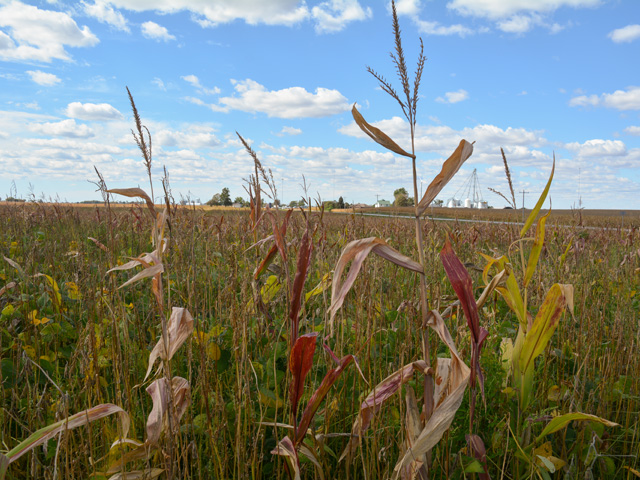Volunteer Corn Attracts Corn Rootworms
Volunteer Corn Could Lead to Increased Corn Rootworm Pressure
ANKENY, Iowa (DTN) -- Potential yield loss from volunteer corn this year isn't the only worry for farmers hit by the 2020 Midwest derecho. Heavier corn rootworm pressure in 2022 could also be a threat.
Northern and western corn rootworm activity could increase next year in areas hit by the derecho, or anywhere corn lodging is an issue, according to Meaghan Anderson, Iowa State University (ISU) Extension field agronomist based in central Iowa.
Anderson recommends farmers with volunteer corn issues not skimp on corn rootworm management for next year's corn crop. This includes investing in biotech traits or soil-applied insecticides.
"Farmers would normally be able to opt out of that below-ground trait going into the next season in corn after soybeans," Anderson told DTN/Progressive Farmer. "I think in some of these fields with a lot of volunteer corn, they absolutely should not do that. We recommend a pyramided trait or soil-applied insecticide for corn."
For rootworm control, look for pyramided Bt hybrids with multiple Bt toxins that target rootworm. These could include Cry34/35AB1 (Herculex RW), Cry3Bb1 (YieldGard Rootworm), and mCry3A (Agrisure RW), and eCry3.1Ab (Duracade).
Pyramided rootworm hybrids can be found under brand names like SmartStax, Qrome, Agrisure Duracade, Agrisure 3122, AcreMax Xtreme or Intrasect Xtreme. For the Handy Bt Trait Table, go to: https://www.texasinsects.org/….
In 2022, there will be one novel rootworm trait, as well, an RNAi trait found in Bayer's SmartStax PRO corn hybrids. It will be in limited availability initially.
Remember not all Bt traits remain effective due to rootworm resistance. The Handy Bt Trait Table can help note which traits might be compromised. ISU evaluations of various Bt traits and soil-applied insecticides for management of corn rootworm larvae can also be found at www.ent.iastate.edu/dept/faculty/gassmann/rootworm.
P[L1] D[0x0] M[300x250] OOP[F] ADUNIT[] T[]
VOLUNTEER CORN
Volunteer corn is always a concern, but the Aug. 10, 2020, derecho heightened anxiety about unwanted corn. Winds hitting 140 miles per hour flattened or damaged millions of acres of corn along its 700-mile-plus path, which caused countless ears and kernels to drop on the ground and many fields not to be harvested. Anderson's territory arguably sustained the most damage from the violent storm.
"We still see some pretty hefty populations of volunteer corn left in soybean fields this year in areas affected by the derecho," Anderson said. "Volunteer corn may not have devastated yields in many fields, but it's a host for corn rootworms.
"When I was out in fields in August looking at volunteer corn, that's where all the corn rootworm beetles were, and that's where they are laying eggs," she continued. "They (rootworm larvae) will be there waiting for corn next year."
Among the many reasons farmers often rotate fields between corn and soybeans annually is to lesson corn rootworm pressure by planting a nonhost crop. If enough volunteer corn exists in a soybean field, Anderson said it can be a "bridge" to higher rootworm populations in fields planted back to corn in 2022.
When corn rootworm larvae hatch in the spring, they begin feeding on corn roots. Adult rootworm beetles feed above ground on corn silks and can interfere with pollination. The insects have earned the nickname "billion-dollar bug" due to their yield- and revenue-robbing reputation.
FARMER ACTION
Central Iowa grain farmer Brock Hansen told DTN his primary worry about volunteer corn is possible higher numbers of corn rootworm larvae and beetles feasting on his corn next year. Almost all of Hansen's 2021 corn acres near Baxter, Iowa, were damaged or blown over by the derecho.
As Hansen harvests soybeans with volunteer corn, which he said isn't "too bad," he plans to write down areas of concern to keep an eye on corn rootworm activity next year.
"My biggest concern is volunteer corn being a host for pests," Hansen said.
To combat corn rootworms, he plans to plant Bayer SmartStax rootworm-resistant hybrids with a full seed treatment. He'll also apply insecticide to control corn rootworm beetles in-season if needed.
Storms are the gift that keeps on threatening. Parts of the Upper Midwest were hit by multiple severe thunderstorms in late August, packing strong straight-line winds that caused extensive corn lodging.
Anderson said farmers with lodged corn this year could deal with volunteer corn problems in 2022. As a result, heavier rootworm pressure could occur in 2023 in areas affected by the storms.
To keep volunteer corn from acting as a host for unwanted pests, management is key. Read DTN's story about volunteer corn management at www.dtnpf.com/agriculture/web/ag/crops/article/2021/09/25/volunteer-corn-management-lessons.
Matthew Wilde can be reached at matt.wilde@dtn.com
Follow him on Twitter @progressivwilde
(c) Copyright 2021 DTN, LLC. All rights reserved.






